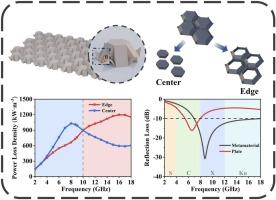3D-Printing Metamaterials with A Quasi-Origami-Hive Structure for Broadband Microwave Absorption Base on Material-Structure Differentiated Strategy
IF 6.3
2区 材料科学
Q2 CHEMISTRY, PHYSICAL
引用次数: 0
Abstract
In the context of increasingly severe electromagnetic pollution, metamaterial microwave absorbers featuring specific three-dimensional architectures have garnered substantial attention. This is attributed to their exceptional microwave dissipation capabilities and unique electromagnetic wave attenuation mechanisms. However, the design of metamaterial absorbers that can concurrently achieve a thin thickness and a broad bandwidth remains a crucial challenge. To address this issue, we put forward a "material-structure" differentiated strategy by employing flake carbonyl iron powder as the filler to fabricate an ultra-broadband microwave absorber with a quasi-origami-hive structure via 3D-printing technology. The superior electromagnetic properties of flake carbonyl iron powder were utilized to enhance low-frequency dissipation. Meanwhile, the resonant coupling mechanism of the periodic structure extended the absorption bandwidth at high frequencies. A Harris hawk optimization algorithm was employed to optimize the unit geometric parameters. When the thickness of the metamaterial absorber was 3 mm, the effective absorption bandwidth reached 11.24 GHz (ranging from 6.76 to 18.00 GHz), with a minimum reflection loss of −30.70 dB. This represented a 175% improvement when compared with conventional plate-like materials of the same thickness. This work provides an innovative solution for electromagnetic compatibility, radar stealth, and electromagnetic protection of electronic components.

基于材料-结构差异化策略的准折纸蜂箱结构宽带微波吸收3d打印超材料
在电磁污染日益严重的背景下,具有特定三维结构的超材料微波吸收剂引起了人们的广泛关注。这是由于其优异的微波耗散能力和独特的电磁波衰减机制。然而,设计出既能实现薄厚度又能实现宽带宽的超材料吸收器仍然是一个关键的挑战。为了解决这一问题,我们提出了“材料-结构”的差异化策略,采用片状羰基铁粉作为填料,通过3d打印技术制造出具有准折纸蜂箱结构的超宽带微波吸收体。利用片状羰基铁粉优越的电磁性能,提高了其低频耗散性能。同时,周期结构的共振耦合机制扩大了高频吸收带宽。采用Harris hawk优化算法对单元几何参数进行优化。当超材料吸收体厚度为3 mm时,有效吸收带宽达到11.24 GHz(范围为6.76 ~ 18.00 GHz),最小反射损耗为−30.70 dB。与相同厚度的传统类板材料相比,这代表了175%的改进。这项工作为电子元件的电磁兼容、雷达隐身和电磁保护提供了一种创新的解决方案。
本文章由计算机程序翻译,如有差异,请以英文原文为准。
求助全文
约1分钟内获得全文
求助全文
来源期刊

Journal of Alloys and Compounds
工程技术-材料科学:综合
CiteScore
11.10
自引率
14.50%
发文量
5146
审稿时长
67 days
期刊介绍:
The Journal of Alloys and Compounds is intended to serve as an international medium for the publication of work on solid materials comprising compounds as well as alloys. Its great strength lies in the diversity of discipline which it encompasses, drawing together results from materials science, solid-state chemistry and physics.
 求助内容:
求助内容: 应助结果提醒方式:
应助结果提醒方式:


